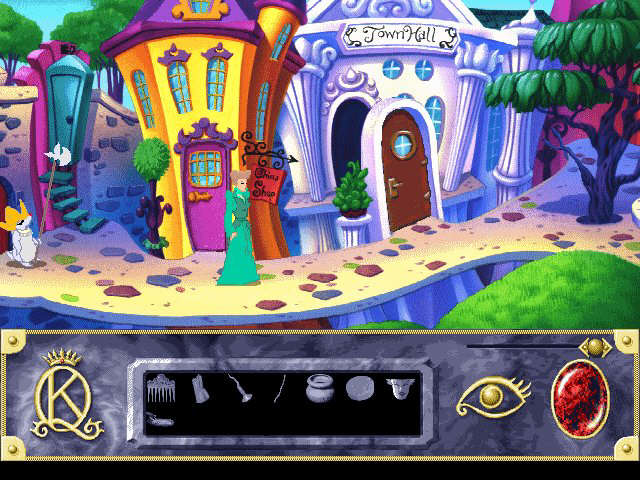King's Quest is largely considered the first graphical
adventure game, allowing the player to visually see the world with colors and
animation. Previous adventure games were
entirely text-based, or had static images to accompany text. This was the first time a player could move
around the screen with a character in an adventure game.
 |
| The CryEngine at its best. |
The game's mechanics were simple: move the character with
the arrow keys, and type commands of one to three words. The parser understood simple verbs and many
objects in the environment, even going so far as to describe otherwise
non-interactive objects in its dictionary.
For instance, the player could type "Look at flag" on the
first screen and be given a description of the flags flying on the castle. The player could do nothing with this
information and could not interact with the flags in any other way, so this
level of detail was purely for flavor text.
Much of the time, the possibilities seem endless: the player
can interact with objects in a variety of ways, and when they can't, the
computer might still understand the intent.
However, players might eventually type a term that the computer doesn't
understand, and the player would grow frustrated.
For instance, a player might not know the proper noun, and
might use a synonym instead which was not programmed in. The player might try to look at an Ogre that
is actually a Troll. Most of the time,
synonyms were accepted, such as fiddle for violin, knife for dagger, rocks for
pebbles, etc. But other times, players
played a game of "Guess the noun".
This was not limited to King's Quest, however; it was a
common complaint against all text adventures of the time. Eventually, the text parser was replaced with
more discrete iconographic options in the King's Quest series, beginning with
King's Quest V.
 |
| By VII, it became completely point-n-click. |
King's Quest developer Sierra On-Line went on to make many
more graphical adventures with the same engine, including Space Quest, Leisure
Suit Larry, Mixed-Up Mother Goose, and other series.
King's Quest itself was well-loved when it first came out,
not only for its new graphical system, but also for its content. The country of Daventry (the locale of the
first King's Quest game) was comprised of fairy tales, including Jack and the
Beanstalk, Hansel and Gretel, Billy Goats Gruff, and more.
Players who recognized the fairy tails would be able to
deduce the solutions to puzzles, making the game more accessible than other
text adventures of the day, which would often take place in wholly imagined
fantasy worlds or require illogic to solve strange puzzles.
Later installments of King's Quest added more fairy tales,
but also included other famous figures from literature and mythology, including
Dracula and Medusa.
 |
| Although I don't remember Snow White needing to clean up after the dwarves all the time. |
In much of the series, points were awarded for completing
puzzles, taking objects, etc. A number
of bonus items could be found in the first game, such as a golden egg and a
golden nut. These items could be used to
solve puzzles, but the player received the most points by solving each puzzle
in ways that allowed players to keep their items.
Players were also rewarded for using clever, non-violent
means. For instance, the player could
kill a dragon with a dagger, or throw water in its face, and the player
received more points for the water solution.
The only notable exception to this in the first game was in killing the
witch from Hansel and Gretel by shoving her in her oven, although this was
probably because it followed the fairy tell best to do this, rather than avoid
the witch altogether.
The first three King's Quest games used the same
engine. By the fourth game, a much more
advanced engine was used, allowing more colors and finer detail, as well as
pausing the game as the player typed, so they didn't feel like they were in a
rush in a dangerous situation.
The first King's Quest game was then remade using the new
engine, but this disturbed many gamers.
Sierra On-Line had planned to remake all three early games with new
engine, but fan disappointment led Sierra to scrap that project.
Oddly enough, fan-made versions of the early games were
eventually made, along with a cult following for them. Perhaps the idea simply wasn't ready to
emerge when Sierra tried it.
 |
| People are fickle. |
The eighth installment added combat and RPG elements, taking
a break from the cerebral puzzle-solving of the previous games. This marked a drastic change in the genre of
the series, as well as the complexity.
The interface for the series up to the seventh installment got gradually
simpler and easier to use, until there was nothing but point-and-click
left. But the eighth installment added
combat, navigation, weapons, health, and a variety of keyboard commands to keep
up with the new features.
The King's Quest series presents a history lesson through
each installment showing the evolution of the adventure genre through the
years, and its eventual disappearance in favor of action and RPG titles.
Read Part II...
Read Part II...
No comments:
Post a Comment